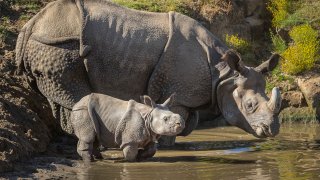
Two young greater one-horned rhinoceros calves braved one of the San Diego Zoo Safari Park’s expansive habitats by their mother’s side for the first time, exploring the massive site with full of curiosity.
Rhinos Asha and Tanaya gave birth to their calves at the Safari Park on March 25 and April 11, just two weeks apart from one another. Since then, the young rhinos have bonded with their mothers privately but didn’t immediately get to interact with other wildlife. That changed last week when wildlife specialists determined the calves were ready to explore the park’s Asian Savanna.
Tanaya and her calf were first to venture off into the savanna, where the mother rhino showed off her favorite spot – a mud wallow. The pair took a dip in the water and a spot the calf seemed to enjoy, according to the zoo.
Ever so cautious, the young rhino, who has not yet been named, stayed near her mother’s side in the water before exploring more of the savanna. There, she encountered for the first time several wildlife animals that live on the property.
Asha and her calf, Arjun, got their chance to explore the savanna together. Slightly braver than his female counterpart, Arjun dared to explore areas a few feet away from his mother. However, he ran back to her side when he encountered a Javan banteng. The duo also enjoyed a fresh dip in the mud wallow.
“Everything is new to the calves right now, so it will be interesting to watch them explore,” senior wildlife care specialist, Jillian King, said in a statement. “We will keep a watchful eye on them and look forward to them meeting more of the wildlife on the savanna soon.”
Greater one-horned rhinos are considered a vulnerable species, with an estimated 3,500 rhinos of that species remaining in the wild. Habitat loss, illegal trafficking of rhino horns and poaching threats all contribute to the species’ vulnerable status. These rhinos used to be widespread in Southeast Asia, but are now only found in Nepal and India, according to the zoo.

